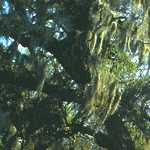NATURE PROFILE
Spanish Moss
Tillandsia usneoides
Some time back, I was perusing a particular botanical manual. This manual
covers the
plants of the northeast quadrant of the country, and for each one includes the
derivation for the Latin name of plant. I find them all interesting to know,
but, in general, they're not all that interesting in themselves. On the day in
question, I happened upon the derivation for the genus, Commelina, and was so taken by it that I
decided to look through the entire manual to see what other
unusual stories might be lurking there.
The book is well over a thousand pages long, and in checking all the genera in it, the only other real story I found was for the genus, Tillandsia, a genus that only barely reaches into the area covered by the book. Tillandsia usneoides is a southern plant but manages to occur in some of the swampy areas of Virginia down near the North Carolina border. It's a plant quite familiar to many people under the name of Spanish Moss. The plant is a bromeliad and is therefore in the same family as the pineapple.
The story: The editor of the manual reported that when the Swedish botanist, Elias Tillands, was a student, he traveled by boat across the Gulf of Bothnia to Stockholm. He was so miserably seasick on the voyage, that he determined not to get back on a boat for the return trip, preferring to return on foot to Abo even though the distance was over 1000 miles.
When Linnaeus was trying to come up with a name for a newly discovered plant from America, he was under the wrong impression that the plant did not like water, and therefore decided to name it after a person, who also did not like water! The second part of the name, usneoides, was chosen because the plant resembles a lichen in the genus Usnea which one often sees draped on trees in a fashion similar to Spanish Moss.
In past times, Spanish Moss was used in upholstery and mattresses and as a packing material. Today, it is not uncommon to see it being used in floral arrangements. (It needs to first be treated in some manner to kill any insects that may be present in it.) Birds also make use of it for nesting materials. Extracts of the plant have also been used medicinally in past times as antidiabetic agents. Research using this plant to lower blood glucose is taking place at Northeast Louisiana University.
This Tillandsia has quite a wide distribution. It can be found from sea-level in southern Virginia to altitudes as high as 8000 feet in Argentina. While still common in areas such as coastal South Carolina, other areas which used to have an abundance of the plant are experiencing a decline, with pollution and a fungus being suggested as possible culprits. In "Evangeline," Longfellow described "....trailing mosses in mid-air Waved like banners that hang on the walls of ancient cathedrals." But when someone writing for American Forests went there in 1992, she reported disappointment at not being able to find any in those same bayous of Atchafalaya that were the setting of the famous poem.
The plant is an epiphyte (rather than a parasite) growing on many species of trees, especially favoring oak and baldcypress. The threadlike stems of the plant can reach many feet in length. They, along with the very narrow leaves, are covered with small , silvery grey scales that are important in trapping water and nutrient-providing dust particles. The small three-parted yellow-green flowers are said to be rather fragrant at night.
© 1997 by Kathy Bilton
For more information about this plant see this page at the Beaufort, South Carolina Library. And if you want to see a wonderful dreamlike photo showing some Spanish Moss, have a look here on the Logues' page.
